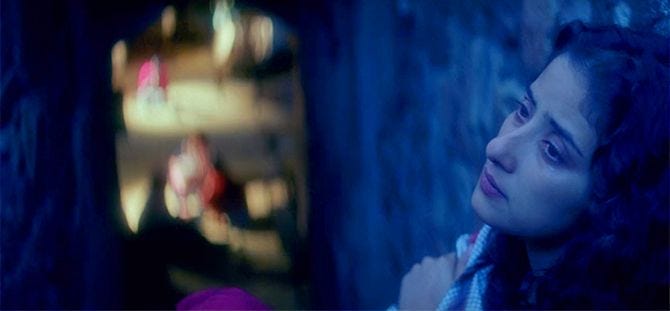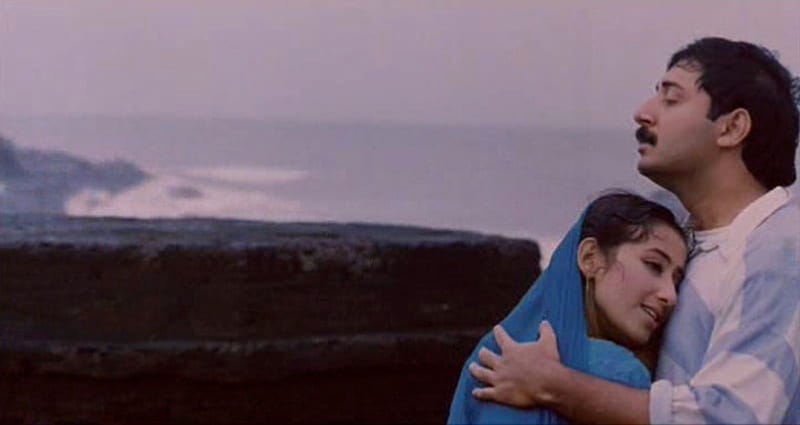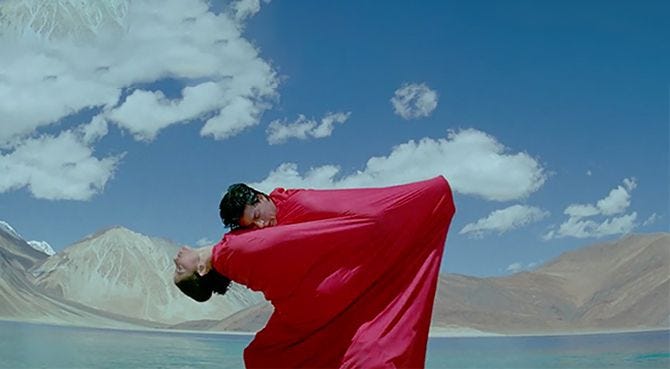Dil Se is different.
Mani Ratnam's heavily debated magnum opus continues to stir a vortex of emotions, even 26 years after its release.
TW: rape, murder, suicide | Spoilers ahead.
With all the praise that’s been heaped on it especially in recent times, there is very little left of my own to say about Mani Ratnam’s 1998 film, Dil Se... The Shah Rukh Khan-Manisha Koirala starrer failed to make a commercial mark at the box office, but has since come around to become a favourite of film critics and a bona fide cult classic. Centered around the Assam Insurgency movement that began in the 1970s, the film depicts the tumultuous relationship between Moina “Meghna”, an undercover separatist from Assam, and Amarkanth “Amar” Verma, a programming executive slash journalist for All India Radio and Moina’s obsessive stalker. Countless analyses, thought pieces, Letterboxd reviews and a couple rewatches later, I think I have finally mustered enough courage to say something of my own about the classic.
The first word that comes to mind when I think about Dil Se.. is unconventional. From the atypical two periods at the end of the title to the unsettling tension between our two protagonists, Ratnam cleverly manages to deceive us at every point of the film the minute we expect something to go the traditional Bollywood romance route. To clear the air, Dil Se is NOT a romantic movie. I wasn’t around when the film released, so I don’t know what the audience’s initial reaction was, but I can say for sure that the title of the film (meaning “From The Heart” in Hindi), the promotional musical sequences as well as the poster boy for romance, Shah Rukh Khan, in the lead role definitely didn’t prepare the viewers for what they were about to witness.
Dil Se is an excellent parody of standard Bollywood romances in a way. Boy stalks girl, they fall in love and then the trouble ensues. Ratnam, Koirala and Khan have all previously worked in films that pitifully fall prey to this overused tactic. Aditya Chopra’s Dilwale Dulhania Le Jaayenge (1995), the film that catapulted Khan into superstardom, starts off with the male lead, Raj (Khan) stalking the female lead, Simran (Kajol), until she finally gives in and “falls in love” with him. Bombay, Ratnam’s own film before Dil Se, which released in the same year as DDLJ, also set against a politically explosive background and also starring Koirala, features a whirlwind romance between the two leads in a similar fashion.
The Indian audience is very used to seeing this trope in romantic Bollywood films, so when we see a whimsical Amar trying to woo a solemn Meghna at the railway platform in the dead of a stormy night in all his absurd tongue-in-cheek fashion, pressing her with questions as she averts her gaze from him, we expect a romance to build. When the two keep bumping into each other, when Amar stalks, chases and annoys the hell out of Meghna, we root for the woman to finally give in and say yes. One hour into the movie and we’re still waiting for some action. Nothing. There is no romance. There is just Amar being a creep and forcing himself on Meghna time and time again. Meghna looks growingly uncomfortable, and so does the audience. And maybe that is when it dawns on us that stalking isn’t supposed to be romantic after all. Maybe the mainstream Bollywood films have simply gaslighted us into believing that it was.
I know everyone thinks that Om Shanti Om is the perfect Bollywood satire and everything, but I think that Dil Se excels unexpectedly in that department too, without even trying. Mani Ratnam uses the same exact template for average Bollywood romantic dramas and brilliantly turns it over the head. No number of magical dream sequences (nearly every song in the movie is a dream sequence) is going to change reality. No amount of wooing is going to make her fall in love with you, or remotely even like you.
Yet when we see a hint of poignancy in Meghna’s eyes when she shows up at the engagement of Amar and Preeti (an effortlessly effervescent Preity Zinta in her big screen debut), much later on in the film, we ask ourselves- does Meghna not deserve love? Irreversible scars from her past have left her battle-hardened for the rest of her life, but a part of her still craves that warmth, that maybe, just maybe, giving into Amar’s crazy fantasies would allow her to experience. But then she snaps back to reality- her reality- and realises that the purpose of her people is way more important than her own life.
Everyone has said this countless times: Amar and Meghna are more of abstract characters than well-rounded individuals. Amar, a well-to-do Government servant from the capital New Delhi, represents India, whereas Meghna, or Moina as she later reveals, an impoverished Assamese girl who has been through traumatic experiences ever since she was a child, represents the neglected, oppressed North East. Throughout the film, Amar gets infatuated with Moina’s beauty, tries to woo her, forces himself on her, chases her around, as she silently suffers with teary eyes, much like the current situation with India and its neglected states, who simply want one thing- freedom. After Saeed Akhtar Mirza, I think Ratnam is the only modern-day director who can carve realistic individuals out of abstract ideas (sorry Imtiaz Ali fans). Amar’s infatuation, passion and ultimately unhinged obsession with Moina is commendably essayed through the Arabic seven stages of love- attraction, infatuation, love, reverence, worship, obsession and death- and visibly portrayed in the song Satrangi Re1.
Another reason why Dil Se stands out so much to me is because it is a tight slap on the face of every jingoistic Bollywood film. We have grown up watching films that romanticise the armed forces, but Dil Se is one of those rare examples that sheds light on the lesser known darker side. Moina’s life is torn apart by the army- her pre-pubescent eyes have witnessed the army pillaging her town and raping and murdering her family. Tragically, she becomes the victim to the same devastating fate. I can’t name a single filmmaker who would have the balls to make a courageous film like this one, even so in today’s times, thanks to the immense monopoly that nationalistic films have on us.
There are a lot of little things about the movie that fascinate me. The films starts off with armed personnel inspecting Amar’s cab, looking for weapons or bombs; the running gag continues for the rest of the movie where Amar jokes about being friends with terrorists and carrying bombs up until the penultimate moment when he realises that Moina is the member of a Separatist group as well as a suicide bomber herself.
Another little detail I liked was the conversation Amar and Meghna have when they’re stranded near Ladakh. Amar jokingly proclaims that once they get married, they will have a couple kids, to which Meghna differs and says they will have eight. I think this is an interesting allegory to the Seven Sisters (Assam, Arunachal Pradesh, Meghalaya, Manipur, Nagaland and Mizoram) and the Brother state of Sikkim in the North East. Amar says that the conflict in their relationship will end once they have kids; Meghna disagrees saying the kids will also participate in the conflict. Amar says that the kids will grow up to look like him; Meghna once again disagrees, to which Amar makes fun of her appearance, very similar to how mainland Indians are actively racist towards indigenous people of the North East. Ratnam’s careful attention to detail is astounding.
I think that the crux of the movie lies in the sentence “You feel terrorism has grown and you’re not to be blamed for it?” that Amar hurls at Moina, as we near the end of the film. This sentence sums up the reality of today- equating the oppressor's violence with the oppressed’s resistance. The saddest part is, a lot of people still do ardently believe in this idea, especially given the current socio-political backdrop around the world, and use it to justify their distaste towards resistance.
Amidst the clutter of nationalistic films that routinely villanise the “internal terrorist,” Ratnam is arguably the first of his kind in mainstream Indian cinema to show WHY the so-called terrorist has to go down the extremist path- years and years of oppression, years and years of empty promises. Dil Se starts with the people of Assam swiftly denying that India has made any progress post-independence, because of its blatant neglect towards the North East, and its ever-increasing military violence. It ends with Amar and Moina in a tight embrace as the bomb goes off, leading to an ear-splitting explosion, an allegory that I have yet to decipher. Perhaps it means that juxtaposing the oppressor with the oppressed will only result in all-round chaos? Maybe I’ll have it figured by the next watch.
For now, all I know is, long live the resistance.
https://dichotomy-of-irony.blogspot.com/2014/07/satrangi-re-seven-stages-of-love.html







